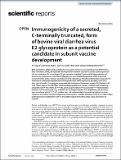Files in this item
Immunogenicity of a secreted, C‑terminally truncated, form of bovine viral diarrhea virus E2 glycoprotein as a potential candidate in subunit vaccine development.
Item metadata
| dc.contributor.author | Lo, Yi Ting | |
| dc.contributor.author | Ryan, Martin Denis | |
| dc.contributor.author | Luke, Garry Alec | |
| dc.contributor.author | Chang, Wan Chen | |
| dc.contributor.author | Wu, Hsing Chieh | |
| dc.date.accessioned | 2023-01-09T17:30:05Z | |
| dc.date.available | 2023-01-09T17:30:05Z | |
| dc.date.issued | 2023-01-06 | |
| dc.identifier | 282860397 | |
| dc.identifier | 8ae43770-0ba2-433f-85e7-826ee470b8da | |
| dc.identifier | 85145841846 | |
| dc.identifier.citation | Lo , Y T , Ryan , M D , Luke , G A , Chang , W C & Wu , H C 2023 , ' Immunogenicity of a secreted, C‑terminally truncated, form of bovine viral diarrhea virus E2 glycoprotein as a potential candidate in subunit vaccine development. ' , Scientific Reports , vol. 13 , 296 . https://doi.org/10.1038/s41598-022-26766-y | en |
| dc.identifier.issn | 2045-2322 | |
| dc.identifier.other | ORCID: /0000-0002-0012-0614/work/126554268 | |
| dc.identifier.uri | https://hdl.handle.net/10023/26726 | |
| dc.description | Funding: This work was supported by the Taiwan Ministry of Science and Technology [MOST-106-2911-I-020-501; MOST-107-2313-B-020-011-MY3] and the UK Biotechnology and Biological Sciences Research Council [BB/P025080/1]. | en |
| dc.description.abstract | Both current live, attenuated, and killed virus vaccines for bovine viral diarrhea virus (BVDV) have their limitations. Here, we report the development of a BVDV subunit vaccine by (i) the expression of a secreted form of a recombinant E2 glycoprotein using BHK21 cells and (ii) determination of the immune responses in mice. The E2 glycoprotein was modified by deletion of the C-terminal transmembrane anchor domain and fusion to a V5 epitope tag. This allowed detection using anti-V5 monoclonal antibodies together with simple purification of the expressed, secreted, form of E2 from the cell media. Furthermore, we genetically fused green fluorescent protein (GFP) linked to E2 via a Thosea asigna virus 2A (T2A) ribosome skipping sequence thereby creating a self-processing polyprotein [GFP-T2A-BVDV-E2trunk-V5], producing discrete [GFP-T2A] and [E2trunk-V5] translation products: GFP fluorescence acts, therefore, as a surrogate marker of E2 expression, BALB/c mice were inoculated with [E2trunk-V5] purified from cell media and both humoral and cellular immune responses were observed. Our antigen expression system provides, therefore, both (i) a simple antigen purification protocol together with (ii) a feasible strategy for further, large-scale, production of vaccines. | |
| dc.format.extent | 11 | |
| dc.format.extent | 2144171 | |
| dc.language.iso | eng | |
| dc.relation.ispartof | Scientific Reports | en |
| dc.subject | Subunit vaccines | en |
| dc.subject | BVDV | en |
| dc.subject | E2 | en |
| dc.subject | Glycoprotein | en |
| dc.subject | 2A | en |
| dc.subject | QH301 Biology | en |
| dc.subject | QR355 Virology | en |
| dc.subject | RM Therapeutics. Pharmacology | en |
| dc.subject | DAS | en |
| dc.subject | SDG 3 - Good Health and Well-being | en |
| dc.subject | MCC | en |
| dc.subject.lcc | QH301 | en |
| dc.subject.lcc | QR355 | en |
| dc.subject.lcc | RM | en |
| dc.title | Immunogenicity of a secreted, C‑terminally truncated, form of bovine viral diarrhea virus E2 glycoprotein as a potential candidate in subunit vaccine development. | en |
| dc.type | Journal article | en |
| dc.contributor.sponsor | BBSRC | en |
| dc.contributor.institution | University of St Andrews. School of Biology | en |
| dc.identifier.doi | https://doi.org/10.1038/s41598-022-26766-y | |
| dc.description.status | Peer reviewed | en |
| dc.identifier.grantnumber | BB/P025080/1 | en |
This item appears in the following Collection(s)
Items in the St Andrews Research Repository are protected by copyright, with all rights reserved, unless otherwise indicated.

